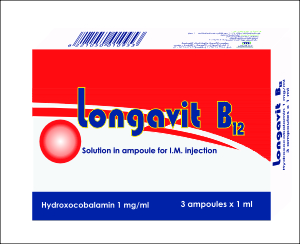Longavit B12 Solution in ampoules for IM Injection (Hydroxocobalamin 1mg/ml) 1 NAME OF THE MEDICINAL PRODUCT Longavit B12 1mg/ml Solution for IM Injection 2 QUALITATIVE AND QUANTITATIVE COMPOSITION 1ml of solution for injection contains 1.045 mg Hydroxocobalamin acetate equivalent to 1 mg Hydroxocobalamin (vitamin B12). 1mg/ml of Hydroxocobalamin equals 1,000 micrograms/ml. Excipients with known effect Each ml of solution contains 9 mg sodium chloride eq. to 3.54 mg sodium. For the full list of excipients, see section 6.1. 3. PHARMACEUTICAL FORM Solution in ampoules for Intramuscular injection. Red, clear solution pH 3.5 to 5 4 CLINICAL PARTICULARS 4.1 Therapeutic indications *Addisonian pernicious anaemia. *Prophylaxis and treatment of other macrocytic anaemias associated with vitamin B12 deficiency. *Tobacco amblyopia and Leber’s optic atrophy. 4.2 Posology and method of administration Intramuscular injection Posology Adults and Children *Addisonian pernicious anaemias and other macrocytic anaemias without neurological involvement. Initially 250 to 1000 micrograms intramuscularly on alternate days for one or two weeks, then 250 micrograms weekly until the blood count is normal. Maintenance: 1000 micrograms every two to three months *Addisonian pernicious anaemia and other macrocytic anaemias with neurological involvement Initially:1000 micrograms on alternate days as long as improvement is occurring. Maintenance:1000 micrograms every two or three months. *Prophylaxis of macrocytic anaemia associated with vitamin B12 deficiency resulting from gastrectomy, some malabsorption syndromes and strict vegetarianism 1000 micrograms every two or three months. *Tobacco amblyopia and Leber’s optic atrophy Initially:1000 micrograms daily by intramuscular injection for two weeks then twice weekly as long as improvement is occurring. Maintenance: 1000 micrograms every one to three months as required. 4.3 Contraindications Hypersensitivity to Hydroxocobalamin or to any of the ingredients in this preparation. Longavit ampoule should not be used for the treatment of megaloblastic anaemia of pregnancy unless vitamin B12 deficiency has been demonstrated. 4.4 Special warnings and precautions for use The dosage schemes given above are normally satisfactory, but regular examination of the blood is advisable. If megaloblastic anaemia fails to respond to Hydroxocobalamin, folate metabolism should be investigated. Doses in excess of 10 micrograms daily may produce a haematological response in patients with folate deficiency. Indiscriminate administration may mask the true diagnosis. Cardiac arrhythmias secondary to hypokalaemia during initial therapy have been reported. Plasma potassium should therefore be monitored during this period. The haematological and neurological state should be monitored regularly to ensure adequacy of therapy. Platelet count should be monitored during the first weeks of use in megaloblastic anaemia due to the possible occurrences of reactive thrombocytosis. This injection contains less than 1mmol (23mg) of sodium per 1ml (essentially ‘sodium-free’). 4.5 Interaction with other medicinal products and other forms of interaction Chloramphenicol-treated patients may respond poorly to Longavit ampoule. Serum concentrations of Hydroxocobalamin may be lowered by oral contraceptives. The above interactions are unlikely to have clinical significance. Antimetabolites and most antibiotics invalidate Vitamin B12 assays by microbiological techniques. 4.6 Fertility, Pregnancy and lactation Longavit ampoule should not be used for the treatment of megaloblastic anaemia of pregnancy unless vitamin B12 deficiency has been demonstrated. Longavit ampoule is secreted into the breast milk but is unlikely to harm the infant, and may be beneficial if the mother and infant are vitamin B12 deficient. No studies on fertility have been performed. 4.7 Effects on ability to drive and use machines None known. 4.8 Undesirable effects The following effects have been reported and are listed below by body system: Blood and lymphatic system disorders: Frequency not known Reactive thrombocytosis can occur during the first weeks of use in megaloblastic anaemia Disorders of the immune system: Frequency not known: Itching, exanthema Rare: Allergic hypersensitivity reactions including skin reactions (e.g. rash, itching), Very rare: Anaphylaxis Cardiovascular disorders: Frequency unknown Arrhythmias secondary to hypokalaemia. Gastro intestinal disorders: Frequency not known: Nausea, vomiting, diarrhea. General disorders: Frequency not known: Fever, dizziness, Injection site reactions including injection site pain, injection site erythema, injection site pruritus, injection site induration and injection site swelling, hot flushes, chills, malaise, pain. Neurological disorders: Frequency not known: Headache, sensory abnormalities such as paraesthesia, tremor. Renal and urinary disorders: Frequency unknown Chromaturia Skin and subcutaneous tissue disorders: Frequency unknown Acneiform and bullous eruptions Reporting of suspected adverse reactions: • Reporting suspected adverse reactions after authorisation of the medicinal product is important. It allows continued monitoring of the benefit/risk balance of the medicinal product. Healthcare professionals are asked to report any suspected adverse reactions via: • e-mail for reporting: pv.followup@edaegypt.gov.eg • Website for reporting: www.edaegypt.gov.eg • Hotline: 15301 • Scan QR code: 4.9 Overdose Treatment is unlikely to be required in the case of overdosage. 5 PHARMACOLOGICAL PROPERTIES 5.1 PHARMACODYNAMIC PROPERTIES Vitamin B12 An intramuscular injection of Hydroxocobalamin produces higher serum levels than the same dose of cyanocobalamin and these levels are well maintained. 5.2 PHARMACOKINETIC PROPERTIES Vitamin B12 is extensively bound to specific plasma proteins called transcobalamins; transcobalamin II appears to be involved in the rapid transport of the cobalamins to tissues. It is stored in the liver, excreted in the bile, and undergoes enterohepatic recycling; part of a dose is excreted in the urine, most of it in the first 8 hours. Vitamin B12 diffuses across the placenta and appears in breast milk. 6. PHARMACEUTICAL PARTICULARS 6.1 List of excipients Sodium chloride Water for injection Glacial acetic acid 6.2 Incompatibilities In the absence of compatibility studies, this product must not be mixed with other medicinal products. 6.3 Shelf life Two years. 6.4 Special precautions for storage Store in a temperature not exceeding 30◦C. 6.5 Nature and contents of container For Local Market: Carton box containing 1 or 3 amber colored glass (Type I) ampoules (its capacity 1.85ml) in a tray, each of 1 ml solution and an inner leaflet. For tender and export: Carton box containing 50 amber colored glass (Type I) ampoules (its capacity 1.85ml) in a tray, each of 1 ml solution and an inner leaflet. 6.6 Special precautions for disposal Single use only, discard any unused content.
